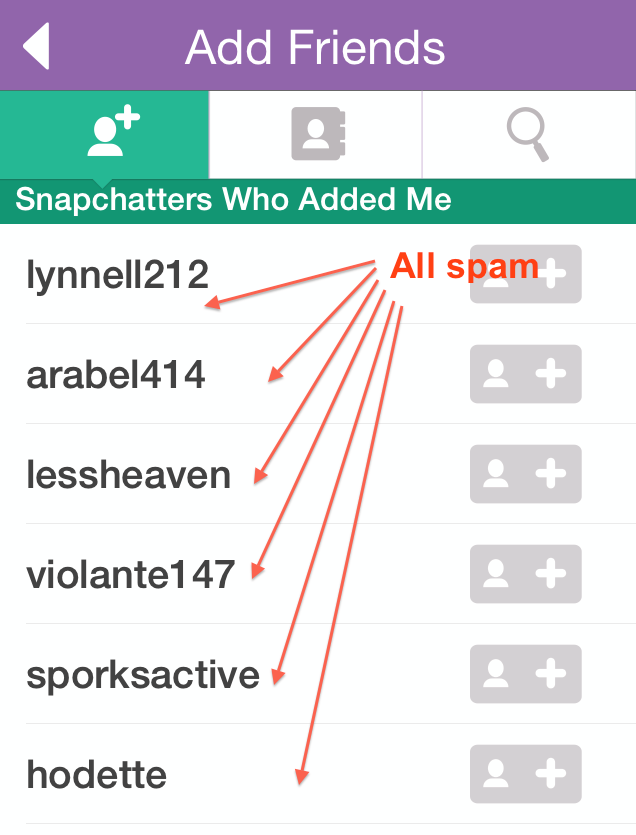I’ve received one too many pictures of boobs.
No, I’m not joking. This is a serious problem, and anyone who has used the ephemeral messaging service Snapchat can surely commiserate with me.
On Sunday, I received a snap and contact request from “arabel414,” who, in text overlaid on her bosom, told me to check out a website allegedly containing leaked Snapchats of a similar nature. This morning I received the same snap.
This has happened a number of times, and while it’s usually a different username, the snap is almost always identical. But the Snapchat spam doesn’t stop there. While most of the spam snaps I receive are of a pornographic nature, I’ve also begun receiving ads for weight loss pills and other unsavory products.
Targeted Pr0n

Until recently, Snapchat has had an allure of privacy; not only is the service built on the idea that your private moments will disappear, but it’s also exclusively a messaging service, meaning snaps sent and received only go to a certain number of people before they evaporate.
But when Snapchat was hit with a privacy breach due to a flaw in the app’s API that exposed the Finds Friends feature, an anonymous hacker leaked millions of Snapchat phone numbers and the security of the application came under fire.
Spam has seemingly increased on Snapchat since its big hack. In the past three days, I have received seven spammy snaps, four consisting of topless women, one featuring diet pills, one advertising male enhancement, and one selling fake Rolexes.
In response to the deluge of complaints fired at Snapchat, the company released a statement that said the team is working on resolving the issue, and dismissed the notion that it was in any way related to the Find Friends hack.
While we expect to minimize spam, it is the consequence of a quickly growing service. To help prevent spam from entering your feed, you can adjust your settings to determine who can send you Snaps. We recommend “Only My Friends” 🙂
Time To Get Serious About Spam

Snapchat, like many other social messaging services, requires people to have usernames to interact with one another; although you can sync your mobile number to Snapchat’s application, photos and videos are sent directly to usernames. Spammers can then crawl different databases for Snapchat usernames to target with indecent proposals—just search Twitter for “add me on Snapchat” to see how easy it is to find usernames to contact.
It’s possible to tailor your settings to improve your privacy on Snapchat, but the setting “Who can send me snaps” is often set to “Everyone.”
Twitter has battled similar spam problems. Since Twitter is an open social network where users publicly share thoughts, links, pictures and video in 140 characters or less, public accounts can become prime targets for spammers that contact users via @-replies or direct messages. You can generally tell by the messenger’s timeline and profile that it is a spambot, thus making it easy to avoid.
On Twitter, users can easily report spam accounts and Twitter will block those users from following or replying to you. But Snapchat lacks these features, which makes it extremely problematic.
On Snapchat, you can’t report users as spam, and it is very difficult to block someone using the service. You first have to add them as a friend, and then go to “My Friends” page and edit their settings.
All those spammers that added me? I have to first add them back, and then block them. This is not the way to deal with spam.
Snapchat has faced criticism in the past for not immediately taking action to protect users and improve the application. In fact, prior to its recent hack, Snapchat was alerted to the potential security breach back in August and did nothing to improve security; then, when anonymous hackers took advantage of that breach, Snapchat failed to apologize for its oversight until after it was heavily scrutinized by the public.
Snapchat once reportedly turned down a $3 billion offer from Facebook. At the time, the move seemed juvenile, but many critics gave the messaging startup the benefit of the doubt. However, if the company led by 23-year-old Evan Spiegel wants to be taken seriously, it needs to become a more sophisticated company and deal with the issues in a way that goes beyond publishing blog posts with emoticons.










